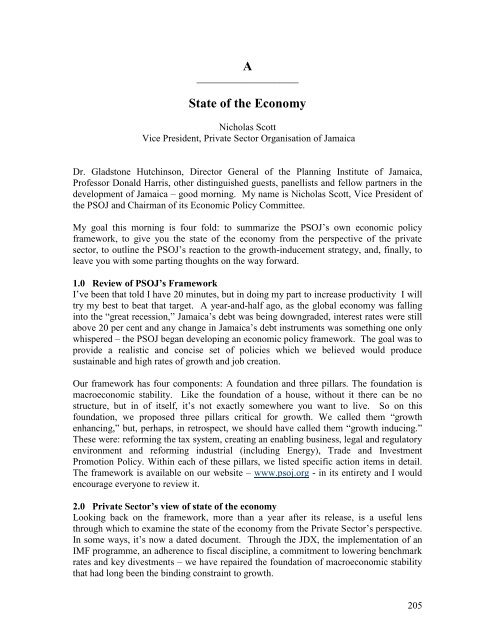PIOJ Growth-Inducement Strategy - Planning Institute of Jamaica
PIOJ Growth-Inducement Strategy - Planning Institute of Jamaica
PIOJ Growth-Inducement Strategy - Planning Institute of Jamaica
You also want an ePaper? Increase the reach of your titles
YUMPU automatically turns print PDFs into web optimized ePapers that Google loves.
A<br />
_____________________<br />
State <strong>of</strong> the Economy<br />
Nicholas Scott<br />
Vice President, Private Sector Organisation <strong>of</strong> <strong>Jamaica</strong><br />
Dr. Gladstone Hutchinson, Director General <strong>of</strong> the <strong>Planning</strong> <strong>Institute</strong> <strong>of</strong> <strong>Jamaica</strong>,<br />
Pr<strong>of</strong>essor Donald Harris, other distinguished guests, panellists and fellow partners in the<br />
development <strong>of</strong> <strong>Jamaica</strong> – good morning. My name is Nicholas Scott, Vice President <strong>of</strong><br />
the PSOJ and Chairman <strong>of</strong> its Economic Policy Committee.<br />
My goal this morning is four fold: to summarize the PSOJ’s own economic policy<br />
framework, to give you the state <strong>of</strong> the economy from the perspective <strong>of</strong> the private<br />
sector, to outline the PSOJ’s reaction to the growth-inducement strategy, and, finally, to<br />
leave you with some parting thoughts on the way forward.<br />
1.0 Review <strong>of</strong> PSOJ’s Framework<br />
I’ve been that told I have 20 minutes, but in doing my part to increase productivity I will<br />
try my best to beat that target. A year-and-half ago, as the global economy was falling<br />
into the “great recession,” <strong>Jamaica</strong>’s debt was being downgraded, interest rates were still<br />
above 20 per cent and any change in <strong>Jamaica</strong>’s debt instruments was something one only<br />
whispered – the PSOJ began developing an economic policy framework. The goal was to<br />
provide a realistic and concise set <strong>of</strong> policies which we believed would produce<br />
sustainable and high rates <strong>of</strong> growth and job creation.<br />
Our framework has four components: A foundation and three pillars. The foundation is<br />
macroeconomic stability. Like the foundation <strong>of</strong> a house, without it there can be no<br />
structure, but in <strong>of</strong> itself, it’s not exactly somewhere you want to live. So on this<br />
foundation, we proposed three pillars critical for growth. We called them “growth<br />
enhancing,” but, perhaps, in retrospect, we should have called them “growth inducing.”<br />
These were: reforming the tax system, creating an enabling business, legal and regulatory<br />
environment and reforming industrial (including Energy), Trade and Investment<br />
Promotion Policy. Within each <strong>of</strong> these pillars, we listed specific action items in detail.<br />
The framework is available on our website – www.psoj.org - in its entirety and I would<br />
encourage everyone to review it.<br />
2.0 Private Sector’s view <strong>of</strong> state <strong>of</strong> the economy<br />
Looking back on the framework, more than a year after its release, is a useful lens<br />
through which to examine the state <strong>of</strong> the economy from the Private Sector’s perspective.<br />
In some ways, it’s now a dated document. Through the JDX, the implementation <strong>of</strong> an<br />
IMF programme, an adherence to fiscal discipline, a commitment to lowering benchmark<br />
rates and key divestments – we have repaired the foundation <strong>of</strong> macroeconomic stability<br />
that had long been the binding constraint to growth.<br />
205
















